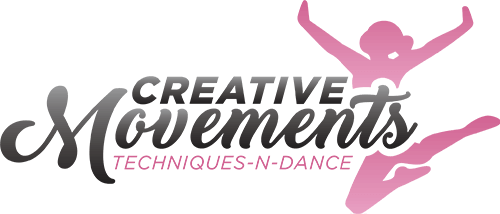Creative Movements is pleased to offer a variety of classes focusing on dance and tumbling. Please contact us today to learn more information or to schedule an evaluation.
Ballet is a classical, highly technical performance dance typically set to orchestrated music. Ballet is an excellent foundation for all dancers due to its complex mixture of technique, coordination and musicality.
Tap dance is a form of dance where dancers use their feet as percussive instruments in accordance with the beat of the music, instead of focusing on body movements and dancing with a partner. The two most common forms of Tap dancing are Rhythm Tap (musically driven) and Broadway Tap (dance and movement-driven). Tap is a great way for dancers to home in on their rhythm skills as they need to use their feet as musical instruments.
Jazz tends to be the most popular style of dance among dancers because it combines all dance styles in a high energy dance … without boundaries. Typically accompanied by upbeat, current music and cool choreography dancers are free to show off their flair and personal style.
Musical Theatre dance is comprised of a variety of dance styles used in musical theatre, including: jazz, ballet, tap, ballroom, street dance, and folk dance. Dancers are, essentially, actors exhibiting musical interpretation.
Lyrical is a fusion of ballet, jazz and modern dance styles … only with deeper feelings and emotions (love, grief, despair) through the dancer’s movements. It’s easy to see the true heart of lyrical is seen in its expressive nature, coupled with proper technique.
Contemporary is a combination of ballet, jazz, lyrical and modern dance styles. While Contemporary uses the fundamental technique of ballet, the additional movements free it from the rules of ballet and modern dances.
Hip Hop is an edgy, raw and intense urban dance style. Also known as Street Dance, Hip Hop is danced to rap, urban and hip-hop music sometimes incorporating popping, locking and crumping. What dancers love most about Hip Hop is their ability to be as innovative and expressive as they want and not have to follow any set choreography due to the dance’s freestyle nature.
Tumbling classes focus on stretching, flexibility, balance, agility, coordination, body strength, and conditioning exercises. Classes are divided into levels: beginner, intermediate, and advanced. Beginner students learn somersaults, backbends, cartwheels, and handstands, while also focusing on the correct technique. Intermediate and advanced tumbling students continue to learn skills with proper progression based on the technique foundation learned in the beginner classes. Intermediate and advanced tumblers focus on the following skills: handsprings, aerials, turning, twisting, connecting skill combinations, and mini trampoline. Trampoline is an all-encompassing sport that builds strength, coordination, agility, and spatial awareness.
Competitive Dance is actually classified a sport due to the athleticism and extreme physical demands of the body. We train dancers (solos, duets, trios or groups) in preparation to perform dance routines (ballet, contemporary, hip-hop jazz, lyrical, modern, musical theatre and tap) before a panel of judges to be scored against other dancers.
Competitive Tumbling classes at Creative Movements refers to acrobatic tumbling in association with the National Acrobat Competition (“NAC”). NAC is composed of local students from various studios that compete against one another. Composed of 10 different tumbling routine levels, NAC class students work on an acrobat routine comparable to their level – ranging from beginner through advanced – consisting of approximately 15 skills. All NAC students are required to take a 1-hour technique class and a 1 hour NAC class per week where they work to perfect their skills in their assigned routine. Students may also compete in trampoline and power tumbling. Students receive a special invite to be a member of the CM Competitive Tumble Team.
